The Health Sciences Library System (HSLS) offers classes on database searching, software applications such as Adobe Photoshop, bibliographic management, molecular biology and genetics, and library orientations. For more information, visit the online course descriptions.
Classes are held on the first floor of Falk Library (200 Scaife Hall) in classroom 1 and conference room B, and on the second floor in the Computer and Media Center classroom 2.
All classes are open to faculty, staff and students of the schools of the health sciences at the University of Pittsburgh and UPMC.
Some classes are also held in the conference room at UPMC Shadyside Libraries.
No registration is required for any of these classes. Seating for classes is first-come, first-served, until the class is full. Classes marked with an asterisk (*) qualify for American Medical Association Category 2 continuing education credit. Class schedules are subject to change. Please consult the online class calendar for the most current information.
HSLS ORIENTATION
Introduction to HSLS Resources and Services at Falk Library
(Meet inside entrance to Library)
Thursday, September 17 10 -11 a.m.
Also offered upon request to groups or individuals. Call 412-648-8796.
Introduction to HSLS Services at UPMC Shadyside
Offered upon request to groups or individuals. Call 412-623-2415.
SEARCHING DATABASES
PubMed Basics* (Falk Library Classroom 1)
Monday, September 14 9:30 -11 a.m.
Wednesday, September 30 10-11:30 a.m.
Tuesday, October 20 3-4:30 p.m.
Searching in CINAHL* (Falk Library Classroom 1)
Tuesday, October 13 1-2:30 p.m.
Focus on Behavioral Medicine: Searching in PsycINFO* (Falk Library Classroom 1)
Thursday, September 17 1-2:30 p.m.
MOLECULAR BIOLOGY AND GENETICS RESOURCES
Locating Gene-centric Information* (Falk Library Conference Room B)
Wednesday, September 2 1-3:30 pm.
Locating Protein Information* (Falk Library Conference Room B)
Wednesday, September 9 1-3:30 p.m.
Genome Browsers* (Falk Library Conference Room B)
Wednesday, September 16 1-3:30 p.m.
SNPs & Genetic Variation* (Falk Library Conference Room B)
Wednesday, September 23 1-3:30 p.m.
Peptide Mass Fingerprinting for Protein Identification* (Falk Library Conference Room B)
Wednesday, September 30 1-3 p.m.
Introduction to Vector NTI* (Falk Library Conference Room B)
Wednesday, October 7 1-3:30 p.m.
Pathway Analysis Tools 1*
Thursday, October 1 10 a.m.-noon (UPMC Shadyside Libraries Conference Room)
Wednesday, October 14 1-3:30 p.m. (Falk Library Conference Room B)
Pathway Analysis Tools 2* (Falk Library Conference Room B)
Wednesday, October 21 1-3:30 p.m.
Microarray Data Analysis* (Falk Library Conference Room B)
Wednesday, October 28 1-3 p.m.
SOFTWARE TRAINING
EndNote Basics (Falk Library Classroom 2)
(Note: This class is usually full. Please arrive 15 minutes in advance to ensure seating.)
Wednesday, September 16 10 a.m.-noon
Wednesday, September 30 10 a.m.-noon
Tuesday, October 13 1 p.m.-3 p.m.
Adobe Photoshop for Beginners (Falk Library Classroom 2)
Thursday, September 10 10 a.m.-noon
Thursday, October 8 10 a.m.-noon
PowerPoint for Beginners (Falk Library Classroom 2)
Thursday, October 22 10 a.m.-noon
Advanced PowerPoint for Presentations (Falk Library Classroom 2)
Thursday, September 24 10 a.m.-noon
The WOW Factor: PowerPoint for Posters (Falk Library Classroom 2)
Thursday, October 15 10-11:30 a.m.
Hands-On Classes at UPMC Shadyside Libraries
Finding Full-Text Articles (UPMC Shadyside Libraries Conference Room)
Offered upon request to groups or individuals. Call 412-623-2415.
Why use PubMed? (UPMC Shadyside Libraries Conference Room)
Wednesday, September 2 3:30-5 p.m.
Find it Quick! (UPMC Shadyside Libraries Conference Room)
Monday, September 21 3:30-5 p.m.
Searching for Nursing Articles Using CINAHL (UPMC Shadyside Libraries Conference Room)
Tuesday, October 13 8:30-9:30 a.m.
LUNCH WITH A LIBRARIAN
These informal, brown-bag lunches are held in Falk Library conference room B. Bring your own lunch. Drinks and dessert are provided. For more information visit the online descriptions.
Testing Beyond the Laboratory: Finding Testing Instruments Used in Research and Clinical Settings
Tuesday, September 15 Noon-1 p.m.
Finding Full-Text Articles
Thursday, October 1 Noon-1 p.m.
Beyond PubMed—Next Generation Literature Searching
Tuesday, October 27 Noon-1 p.m.
Thursday @ Three Library Information Series
These informal sessions are held in the conference room at UPMC Shadyside Libraries.
Timesaving Resources for Physicians
Thursday September 17 3-4 p.m.
What are RSS Feeds? How Can They Make Your Life Easier?
Thursday, October 1 3-4 p.m.
CUSTOMIZED CLASSES
Customized classes can be developed for your department, course, or other group.
LEARNING @ YOUR PACE
These online tutorials provide information on getting started at HSLS, focusing on the Web site and popular resources.
![]() GoPubMed is a free biomedical literature search tool that expands on PubMed search results through ontology and categorization rather than chronology. After search terms are entered, GoPubMed sorts results into four categories: What, Who, Where, and When. These correspond to relevant concepts, authors, affiliations, journals, and publication dates. The categories expand and collapse for easy viewing.
GoPubMed is a free biomedical literature search tool that expands on PubMed search results through ontology and categorization rather than chronology. After search terms are entered, GoPubMed sorts results into four categories: What, Who, Where, and When. These correspond to relevant concepts, authors, affiliations, journals, and publication dates. The categories expand and collapse for easy viewing.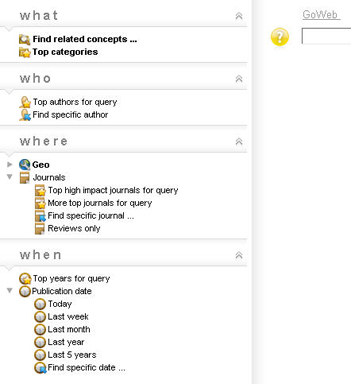 The What category groups search results into three Top Categories: Gene Ontology ( GO; controlled vocabulary for genes and gene products), Medical Subject Headings ( MeSH; controlled vocabulary thesaurus from the National Library of Medicine), and the Universal Protein Resource ( UniProt; protein sequence and function).
The What category groups search results into three Top Categories: Gene Ontology ( GO; controlled vocabulary for genes and gene products), Medical Subject Headings ( MeSH; controlled vocabulary thesaurus from the National Library of Medicine), and the Universal Protein Resource ( UniProt; protein sequence and function).
 To avoid bookmarking problems, the best solution is to bookmark the
To avoid bookmarking problems, the best solution is to bookmark the 
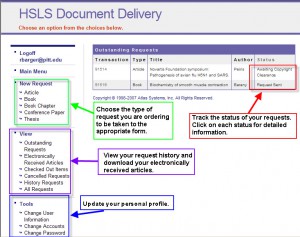
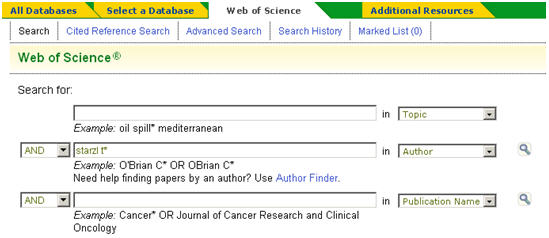
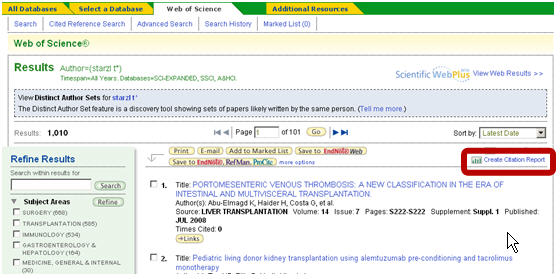
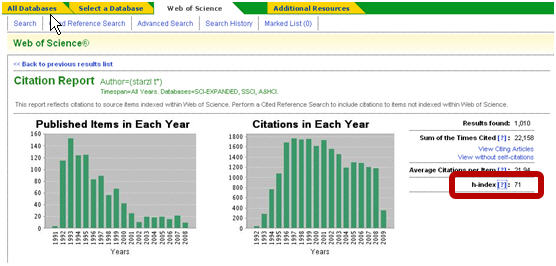
 The Health Sciences Library System (HSLS) is pleased to announce expanded library service at the new Children’s Hospital of Pittsburgh (CHP) of UPMC in Lawrenceville. Located on the sixth floor of the hospital in the center of family and clinical activity, the bright and spacious Family Resource Center includes separate areas for the Moulis Children’s, Young Adult, and Family Health Libraries as well as the Blaxter Medical Library.
The Health Sciences Library System (HSLS) is pleased to announce expanded library service at the new Children’s Hospital of Pittsburgh (CHP) of UPMC in Lawrenceville. Located on the sixth floor of the hospital in the center of family and clinical activity, the bright and spacious Family Resource Center includes separate areas for the Moulis Children’s, Young Adult, and Family Health Libraries as well as the Blaxter Medical Library.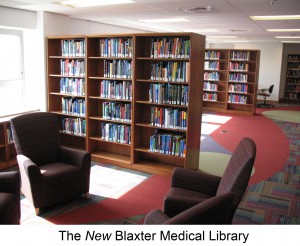 Also available for clinicians’ use is the addition of a wireless conference room, private study carrels, and a separate open space with seven desktop computers. New clinical library services also include classes on searching bibliographic databases such as PubMed, CINAHL and Embase, EndNote training, and HSLS orientation, with other classes to be added over time. Individual search consultations continue to be available on request.
Also available for clinicians’ use is the addition of a wireless conference room, private study carrels, and a separate open space with seven desktop computers. New clinical library services also include classes on searching bibliographic databases such as PubMed, CINAHL and Embase, EndNote training, and HSLS orientation, with other classes to be added over time. Individual search consultations continue to be available on request. family members who need a temporary office while their child is hospitalized. Adults can also relax in a comfortable lounge with a fireplace and solarium stocked with recreational reading materials. CHP features wireless Internet connection throughout, for both family and clinical use. The Moulis Children’s Library continues to offer high-quality children’s books and audiobooks for infants through early readers, while the Young Adult Library houses the latest in young adult fiction and non-fiction books and audiobooks along with computers and a flat-screen television. At the Family Health Library, families can research their child’s condition, either by browsing our extensive collection or working with an HSLS medical librarian to search for more detailed information.
family members who need a temporary office while their child is hospitalized. Adults can also relax in a comfortable lounge with a fireplace and solarium stocked with recreational reading materials. CHP features wireless Internet connection throughout, for both family and clinical use. The Moulis Children’s Library continues to offer high-quality children’s books and audiobooks for infants through early readers, while the Young Adult Library houses the latest in young adult fiction and non-fiction books and audiobooks along with computers and a flat-screen television. At the Family Health Library, families can research their child’s condition, either by browsing our extensive collection or working with an HSLS medical librarian to search for more detailed information.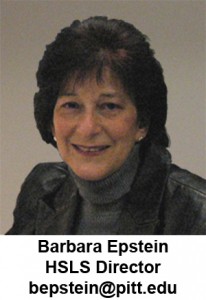 Like most other programs in the University and the health center, HSLS has been adversely affected by the ongoing global economic crisis. Budget support has declined, leading to difficult decisions about collections and services.
Like most other programs in the University and the health center, HSLS has been adversely affected by the ongoing global economic crisis. Budget support has declined, leading to difficult decisions about collections and services.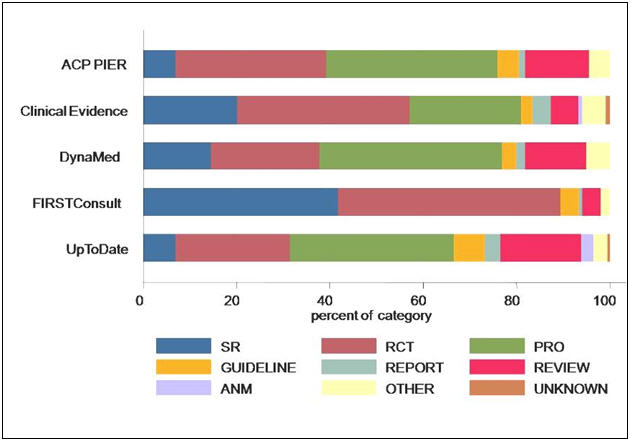

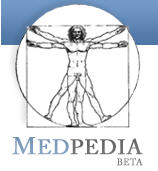
 In March, Ansuman Chattopadhyay, head of the Health Sciences Library System’s Molecular Biology Information Service, traveled to Delhi, India, to lecture at the International Workshop on Psychiatric Genetics, Ethics and Related Methodological Issues. In addition to Chattopadhyay, other presenters included faculty from the University of Pittsburgh, University of Pennsylvania and University of Virginia, as well as the director of India’s Centre for DNA Fingerprinting and Diagnostics (CDFD).
In March, Ansuman Chattopadhyay, head of the Health Sciences Library System’s Molecular Biology Information Service, traveled to Delhi, India, to lecture at the International Workshop on Psychiatric Genetics, Ethics and Related Methodological Issues. In addition to Chattopadhyay, other presenters included faculty from the University of Pittsburgh, University of Pennsylvania and University of Virginia, as well as the director of India’s Centre for DNA Fingerprinting and Diagnostics (CDFD). The AMA Manual of Style: A Guide for Authors and Editors, 10th edition, is now available online to HSLS users. The online edition contains information needed by medical and scientific researchers, writers, and editors to produce well-organized, clear, readable, and authoritative manuscripts.
The AMA Manual of Style: A Guide for Authors and Editors, 10th edition, is now available online to HSLS users. The online edition contains information needed by medical and scientific researchers, writers, and editors to produce well-organized, clear, readable, and authoritative manuscripts.